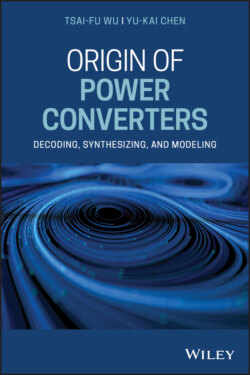Читать книгу Origin of Power Converters - Tsai-Fu Wu - Страница 15
1.1 Power Processing Systems
ОглавлениеConfiguration of a power processing system can be illustrated in Figure 1.1, which mainly includes input filter, power converter, feedback/feedforward circuits, controller, gate driver, and protection circuit. The input source can be obtained from utility outlet/grid or renewable energy generators, such as photovoltaic panel, wind turbine, geothermal heat pump, etc. Its voltages and currents can be any form, and their amplitudes might vary with time or fluctuate frequently. At the output side, the load may require various voltage and current forms, too. Thus, a proper power converter topology along with a promising controller is usually required to realize a power processing system.
Conventionally, the conceptual block diagram of a power processing system shown in Figure 1.1 can be realized by the circuit shown in Figure 1.2, which, as an example, is a linear regulator. In the circuit, semiconductor switch QN is operated in linear region to act as a variable resistor, which can absorb the voltage difference between input voltage Vi and output voltage Vo and in turn regulate Vo under load variation. The primary merits of a linear regulator include low output voltage ripple and low noise interference. However, it has many drawbacks, such as the transformer with low operating frequency results in bulky size and heavy weight, semiconductor QN operating in linear region results in high power loss and low efficiency, and the low efficiency requires a large, heavy heat sink and even needs forced ventilation. These drawbacks have limited its wide applications to compact electronic products, renewable power generators, and energy harvesters, where efficiency and size are the essential concerns.
Figure 1.1 Configuration of a power processing system.
Figure 1.2 Block diagram of a linear regulator.
To improve efficiency and release the aforementioned limitations, switching power regulators were developed. A typical configuration of the switching regulators is shown in Figure 1.3, where in the power converter, switch M1 is operated in saturation region (if using BJT as a switch) or in ohmic region (if using MOSFET as a switch), reducing conduction loss dramatically. At the input side, the corner frequency of the filter is close to switching frequency, and its size and weight can be also reduced significantly. If isolation is required, high frequency transformer will be introduced to the converter, and its size and weight are relatively small as compared with a low‐frequency one (operating at 50/60 Hz). In general, a switching regulator has the merits of high power density, small volume, low weight, improved efficiency, and cost and component reduction. There still exist several limitations, such as resulting in high switching noise, increasing analysis and design complexity, and requiring sophisticated control. Although switching regulators have the limitations, thanks to recent advances in high efficiency and high frequency component development, nanoscale integrated circuit (IC) fabrication technique, and analysis tool, they have been widely applied to electronic products, energy harvesting, and power quality improvement. For further discussion, we will focus on switching regulators only.
For a switching regulator or a more general term, switching power converter, the input source can be either AC or DC form, and the output load can be also supplied by either AC or DC form. Thus, there are four types of combinational forms in classifying power converter topologies, which are AC to DC, AC to AC, DC to AC, and DC to DC. In Figure 1.3, the rectifier converts AC to DC, and the power converter converts DC to DC. Typically, a power processing system may need multiple power converters to collaborate each other, but they might be integrated into a single power stage for certain applications, such as a notebook adapter consisting of a rectifier (AC to DC), a power factor corrector (DC to DC), and an isolated regulator (DC to DC), which can be integrated into a bridgeless isolated regulator. A power converter requires at least a control gear or switch to control power flow between source and load, and it might need some buffers or filters to smooth and hold up voltage and current, which can be illustrated in Figure 1.4. The switch can be realized with BJT, MOSFET, IGBT, GTO, etc. along with freewheeling diodes. It is worth noting that recent advances in wide‐bandgap switching device development, such as SiC and GaN, have merited to switching power converters because their switching losses have been reduced significantly. The buffer or filter is realized with capacitor alone or capacitor–inductor pair. If it requires galvanic isolation, a transformer is introduced into the converter. Additionally, the transformer provides another degree of freedom in tuning input‐to‐output voltage ratio and can implement multiple outputs readily. To fulfill multiple functions or increase power capacity, converters can be connected in series or parallel, which will complicate analysis, design, and control.
Figure 1.3 Block diagram of a switching regulator.
As shown in Figure 1.4, connecting switch(es) and capacitors/inductors to form a power converter sounds simple. However, how to configure a power converter to achieve step‐up, step‐down, and step‐up/step‐down DC output, AC output, PWM control, variable frequency control, etc. is not an easy task. Even with the same step‐up/step‐down transfer ratio, there exist different converter topologies, and they might have different dynamic performances and different component stresses. Among the four types of power converter topologies is the DC to DC, simplified to DC/DC, converter type relatively popular. In the following, we will first present how to figure out the derivation of DC/DC converter topologies, on which the rest of converter types will be discussed. Exploring systematic approaches to developing power converter topologies is the unique feature of this book.
Figure 1.4 Possible components in a power converter.
